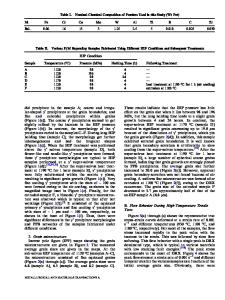Microstructures and mechanical properties of hot isostatically pressed powder metallurgy Alloy APK-1
- PDF / 6,798,059 Bytes
- 10 Pages / 603.28 x 788 pts Page_size
- 98 Downloads / 468 Views
I.
INTRODUCTION
IN recent years, powder metallurgy (P/M) has become increasingly attractive as a processing technique for advanced superalloys. ~ The powder route, besides virtually eliminating segregation effects in highly alloyed materials, offers the potential for producing a fine grained structure. These characteristics may be expected to promote strength and toughness in components such as gas turbine discs which are subject to intermediate service temperatures. Further, significant reductions in finished component cost can be realized due to reduced machining labor and improved material utilization. Before realizing the potential of the P/M technique a unique set of problems has to be solved. One such problem is associated with porosity. This can be minimized by careful canning techniques, but a certain amount due to gases entrapped within the powder particles is generally difficult to eliminate. Another undesirable effect is the precipitation of titanium rich MC carbides on the surface of the powder particles during pressing. These carbide networks, which are fairly stable, impede the growth of recrystallized grains and promote interparticle fracture. The reasons for preferential precipitation at the powder particle boundaries have not been clear. The precipitation appears to be associated with some impurities since the thickness of carbon containing films in prior particle boundaries of P/M IN-100 is known to increase with oxygen and nitrogen contents. 2 It is speculated by some authors 3 that powder particle surface oxides formed during powder processing act as nucleants for carbide precipitation. The oxide-carbide morphology is retained at the prior particle boundary4 even after consolidation. It has been found that prior particle boundary (PPB) decoration can be minimized either by lowering carbon content5 or by increasing the refractory metal content6 of the alloy. Accordingly, P/M versions of some conventional alloys such as Ren6 95, Astroloy, and IN- 100 have been produced, and their chemistries modified and balanced to suppress particle boundary carbide precipitation. Alloy APK-1 is one such tailored alloy, and is being produced by Henry Wiggin T. L. PRAKASHand E. S. BHAGIRADHARAO, Scientists,and Y. N. CHARI, Senior Scientific Assistant, are all with Defence Metallurgical Research Laboratory, Hyderabad-500258, India. R. THAMBURAJ, Research Scholarformerlywith DefenceMetallurgicalResearch Laboratory, is now with the Departmentof MechanicalEngineering,Carleton University, Ottawa, OntarioK1S 5B6, Canada. ManuscriptsubmittedAugust 17, 1981. METALLURGICALTRANSACTIONSA
and Company Limited for gas turbine disc applications. The chemical composition of this alloy (Table I) is similar to that of Astroloy except for the carbon content, which is significantly lower. The aim of this study is to understand the manner in which process variables influence the mechanical properties of powder metallurgy alloy APK-1. Tensile properties have been evaluated for various combinations of HIP and heat treatment parameter
Data Loading...











